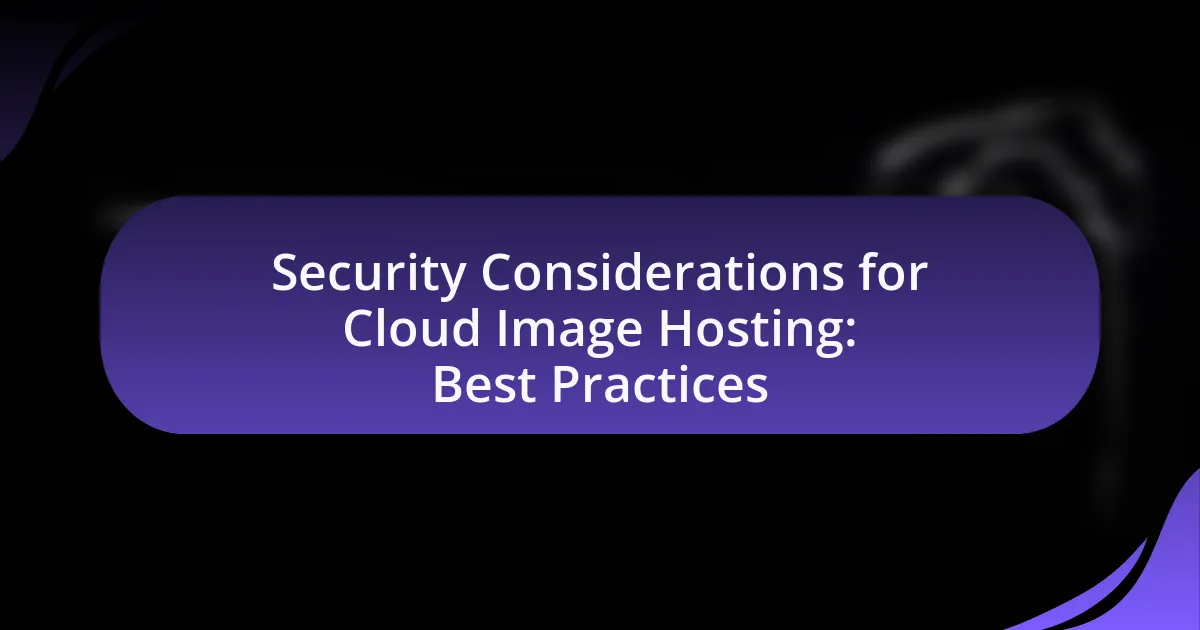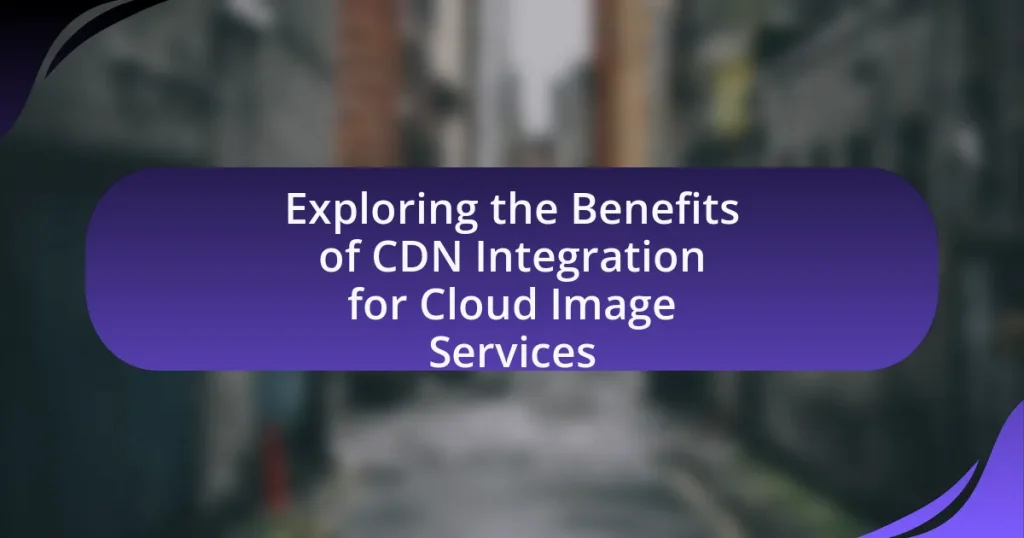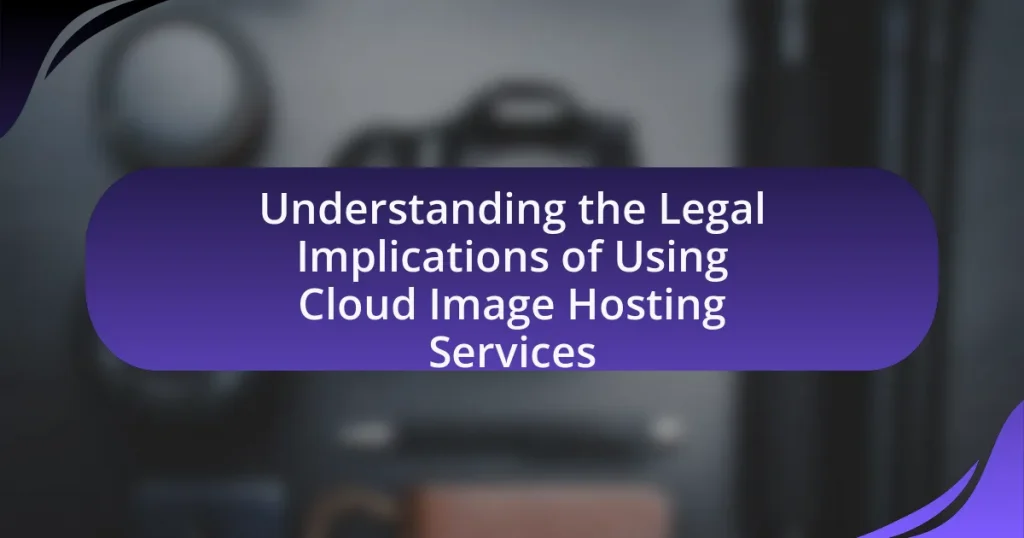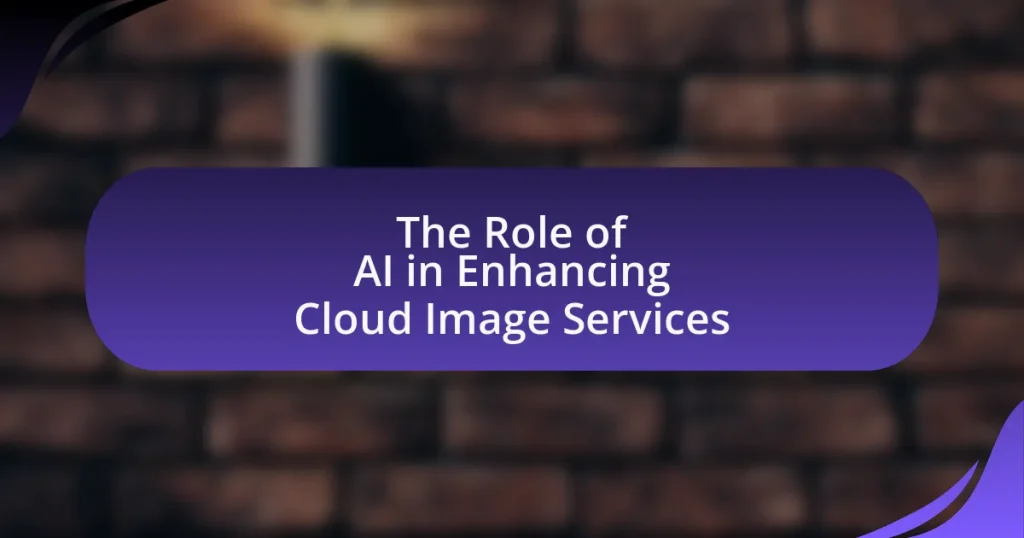The article focuses on key security considerations for cloud image hosting, emphasizing best practices to protect sensitive data. It covers essential topics such as data encryption, access control, and the importance of regular security audits to mitigate risks of data breaches. The discussion includes common causes of breaches, the role of encryption in securing images during transmission and storage, and the significance of multi-factor authentication. Additionally, it highlights emerging trends in security, including the use of artificial intelligence and blockchain technology, while providing practical tips for organizations to enhance their cloud image security posture.
What are the key security considerations for cloud image hosting?
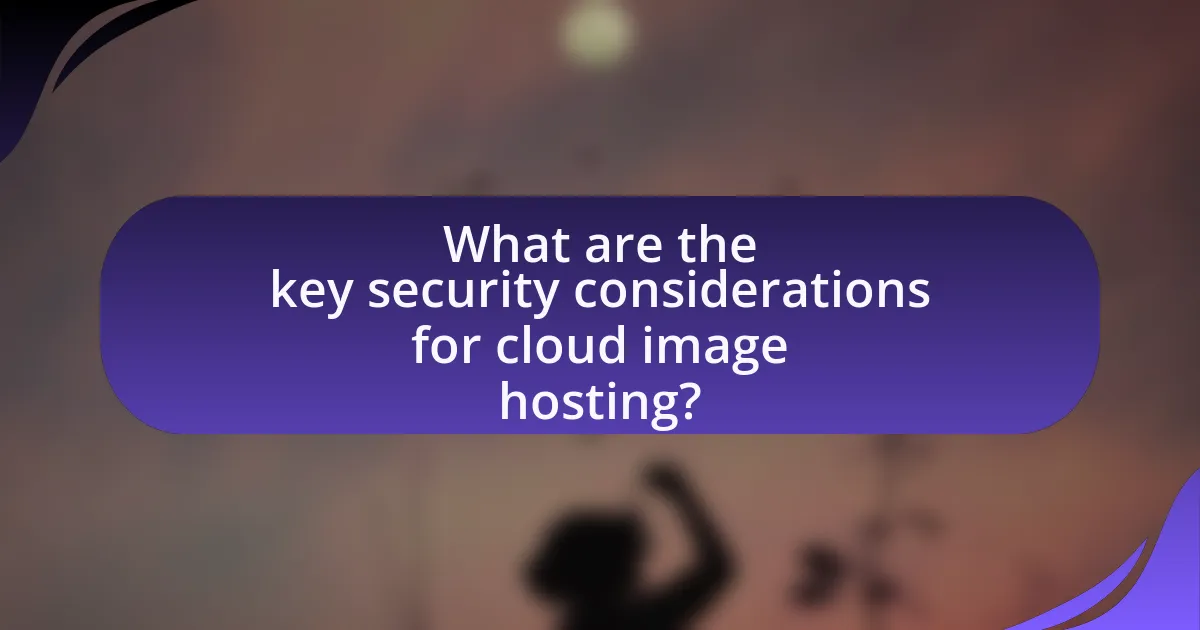
Key security considerations for cloud image hosting include data encryption, access control, and regular security audits. Data encryption protects images both in transit and at rest, ensuring that unauthorized users cannot access sensitive information. Access control mechanisms, such as role-based access and multi-factor authentication, limit who can view or modify images, reducing the risk of data breaches. Regular security audits help identify vulnerabilities and ensure compliance with security standards, thereby maintaining the integrity and confidentiality of hosted images.
How do data breaches impact cloud image hosting security?
Data breaches significantly undermine cloud image hosting security by exposing sensitive user data and compromising the integrity of hosted images. When a data breach occurs, unauthorized individuals can gain access to stored images, metadata, and associated user information, leading to potential misuse or exploitation. For instance, the 2020 Canva data breach affected 137 million users, highlighting how vulnerabilities in cloud services can lead to widespread data exposure. This breach not only jeopardized user privacy but also raised concerns about the reliability of cloud image hosting providers. Such incidents emphasize the necessity for robust security measures, including encryption and access controls, to protect against unauthorized access and maintain user trust in cloud image hosting services.
What are the common causes of data breaches in cloud image hosting?
Common causes of data breaches in cloud image hosting include inadequate security measures, misconfigured cloud settings, and phishing attacks. Inadequate security measures often result from weak passwords or lack of two-factor authentication, making accounts vulnerable to unauthorized access. Misconfigured cloud settings can expose sensitive data to the public, as seen in incidents where improperly set permissions allowed unauthorized users to access private images. Phishing attacks target users to gain credentials, leading to unauthorized access to cloud accounts. According to a report by Verizon, 22% of data breaches involved phishing, highlighting its prevalence as a cause of security incidents.
How can organizations assess their vulnerability to data breaches?
Organizations can assess their vulnerability to data breaches by conducting comprehensive risk assessments that evaluate their security policies, procedures, and technologies. This process involves identifying sensitive data, analyzing potential threats, and reviewing existing security measures to determine their effectiveness. According to the 2021 Verizon Data Breach Investigations Report, 85% of breaches involved a human element, highlighting the importance of assessing employee training and awareness as part of the evaluation. Additionally, organizations can utilize vulnerability scanning tools and penetration testing to identify weaknesses in their systems, further informing their security posture.
What role does encryption play in securing cloud images?
Encryption plays a critical role in securing cloud images by protecting data from unauthorized access and ensuring confidentiality. When images are encrypted, they are transformed into a format that is unreadable without the appropriate decryption key, thus safeguarding sensitive information from potential breaches. According to a report by the Cloud Security Alliance, 64% of organizations cite data protection as a primary reason for adopting encryption in cloud environments. This statistic underscores the importance of encryption in maintaining the integrity and privacy of cloud-stored images.
How does encryption protect images during transmission?
Encryption protects images during transmission by converting the image data into a coded format that is unreadable to unauthorized users. This process ensures that even if the data is intercepted during transmission, it cannot be deciphered without the appropriate decryption key. For instance, protocols like HTTPS utilize encryption standards such as TLS (Transport Layer Security) to secure data in transit, making it extremely difficult for attackers to access or manipulate the images. According to a report by the National Institute of Standards and Technology (NIST), encryption significantly reduces the risk of data breaches, thereby enhancing the overall security of sensitive information transmitted over networks.
What types of encryption should be used for stored images?
Symmetric encryption and asymmetric encryption are the two primary types of encryption that should be used for stored images. Symmetric encryption, such as AES (Advanced Encryption Standard), is efficient for encrypting large files like images due to its speed and lower computational overhead. Asymmetric encryption, such as RSA (Rivest-Shamir-Adleman), is useful for securely sharing encryption keys but is generally slower and less efficient for large data sets.
Using AES, which is widely recognized and adopted, ensures that images are securely encrypted with a key size of at least 256 bits, providing a high level of security. RSA can be employed to encrypt the AES key itself, allowing secure transmission of the key without exposing the encrypted images. This combination of symmetric and asymmetric encryption methods enhances the overall security of stored images in cloud environments.
Why is access control critical in cloud image hosting?
Access control is critical in cloud image hosting because it ensures that only authorized users can access, modify, or share sensitive images. This is essential for protecting intellectual property, personal data, and compliance with regulations such as GDPR, which mandates strict data access controls. Without effective access control, unauthorized users could exploit vulnerabilities, leading to data breaches that can result in significant financial and reputational damage. For instance, a study by IBM found that the average cost of a data breach in 2021 was $4.24 million, highlighting the financial implications of inadequate access control measures.
What are the best practices for implementing access control?
The best practices for implementing access control include defining user roles, enforcing the principle of least privilege, regularly reviewing access permissions, and utilizing multi-factor authentication. Defining user roles ensures that individuals have access only to the resources necessary for their job functions, which minimizes potential security risks. Enforcing the principle of least privilege restricts user permissions to the minimum required, reducing the attack surface. Regularly reviewing access permissions helps identify and revoke unnecessary access, thereby maintaining a secure environment. Utilizing multi-factor authentication adds an additional layer of security, making unauthorized access more difficult. These practices are supported by guidelines from organizations such as the National Institute of Standards and Technology (NIST), which emphasizes the importance of role-based access control and regular audits in their publications on security frameworks.
How can organizations monitor access to their cloud images?
Organizations can monitor access to their cloud images by implementing robust logging and auditing mechanisms. These mechanisms track user activities, including who accessed which images, when, and from where, thereby providing a comprehensive audit trail. For instance, cloud service providers like AWS and Azure offer built-in logging services such as AWS CloudTrail and Azure Monitor, which automatically log API calls and user activities. Additionally, organizations can utilize access control policies and identity management solutions to enforce permissions and monitor access attempts, ensuring that only authorized users can view or modify cloud images. This approach not only enhances security but also aids in compliance with data protection regulations by maintaining detailed records of access events.
What best practices should be followed for secure cloud image hosting?

To ensure secure cloud image hosting, implement strong access controls, including multi-factor authentication and role-based permissions. These measures prevent unauthorized access and protect sensitive images. Additionally, encrypt images both in transit and at rest to safeguard data from interception and breaches. Regularly update and patch cloud services to mitigate vulnerabilities, as outdated software can be an entry point for attacks. Employ a reliable backup strategy to recover images in case of data loss or corruption. Finally, conduct regular security audits and compliance checks to identify and address potential risks, ensuring adherence to industry standards.
How can organizations ensure compliance with security standards?
Organizations can ensure compliance with security standards by implementing a comprehensive security framework that includes regular audits, employee training, and adherence to established guidelines such as ISO 27001 or NIST. Regular audits help identify gaps in security practices, while employee training ensures that staff are aware of security protocols and best practices. Adhering to established guidelines provides a structured approach to security management, which has been shown to reduce vulnerabilities and enhance overall security posture. For instance, organizations that follow ISO 27001 standards report a 30% reduction in security incidents, demonstrating the effectiveness of structured compliance efforts.
What are the key regulations affecting cloud image hosting security?
Key regulations affecting cloud image hosting security include the General Data Protection Regulation (GDPR), the Health Insurance Portability and Accountability Act (HIPAA), and the Federal Risk and Authorization Management Program (FedRAMP). GDPR mandates strict data protection and privacy measures for personal data of EU citizens, requiring cloud providers to implement robust security protocols. HIPAA establishes standards for protecting sensitive patient information, necessitating secure storage and transmission of health-related images. FedRAMP provides a standardized approach to security assessment for cloud services used by U.S. federal agencies, ensuring compliance with federal security requirements. These regulations collectively enforce stringent security measures to protect data integrity and privacy in cloud image hosting.
How can compliance audits enhance security measures?
Compliance audits enhance security measures by systematically evaluating an organization’s adherence to established security standards and regulations. These audits identify vulnerabilities and gaps in security protocols, ensuring that necessary controls are in place to protect sensitive data. For instance, organizations that undergo regular compliance audits, such as those aligned with the General Data Protection Regulation (GDPR) or the Health Insurance Portability and Accountability Act (HIPAA), demonstrate improved data protection practices and reduced risk of data breaches. Studies show that companies with robust compliance audit processes experience 50% fewer security incidents compared to those without such measures, highlighting the effectiveness of compliance audits in strengthening overall security posture.
What are the benefits of using multi-factor authentication?
Multi-factor authentication (MFA) significantly enhances security by requiring users to provide multiple forms of verification before accessing an account. This additional layer of security reduces the risk of unauthorized access, as even if a password is compromised, an attacker would still need the second factor, such as a text message code or biometric verification, to gain entry. According to a study by the Cybersecurity & Infrastructure Security Agency, MFA can block over 99% of automated cyberattacks, demonstrating its effectiveness in protecting sensitive information in cloud environments.
How does multi-factor authentication enhance security for cloud image hosting?
Multi-factor authentication (MFA) enhances security for cloud image hosting by requiring users to provide multiple forms of verification before accessing their accounts. This additional layer of security significantly reduces the risk of unauthorized access, as it is not sufficient for an attacker to simply obtain a password; they must also have access to a second factor, such as a mobile device or biometric data. According to a study by Microsoft, MFA can block over 99.9% of account compromise attacks, demonstrating its effectiveness in safeguarding sensitive data stored in cloud environments.
What are the challenges of implementing multi-factor authentication?
The challenges of implementing multi-factor authentication (MFA) include user resistance, complexity in integration, and potential accessibility issues. User resistance often arises from the perception that MFA adds inconvenience to the login process, leading to lower adoption rates. Complexity in integration can occur when organizations need to incorporate MFA into existing systems, which may require significant technical resources and expertise. Additionally, accessibility issues may affect users with disabilities or those in regions with limited technology, making it difficult for them to utilize MFA effectively. These challenges can hinder the overall effectiveness of MFA in enhancing security.
How can regular security assessments improve cloud image hosting security?
Regular security assessments enhance cloud image hosting security by identifying vulnerabilities and ensuring compliance with security standards. These assessments systematically evaluate the cloud infrastructure, applications, and data storage practices, allowing organizations to detect weaknesses before they can be exploited by malicious actors. For instance, a study by the Cloud Security Alliance found that organizations conducting regular security assessments reduced their risk of data breaches by up to 50%. By implementing the findings from these assessments, organizations can strengthen their security posture, protect sensitive image data, and maintain customer trust.
What types of security assessments should be conducted?
The types of security assessments that should be conducted include vulnerability assessments, penetration testing, risk assessments, and compliance audits. Vulnerability assessments identify weaknesses in systems and applications, while penetration testing simulates attacks to evaluate security measures. Risk assessments analyze potential threats and their impact on the organization, and compliance audits ensure adherence to relevant regulations and standards. These assessments are essential for maintaining robust security in cloud image hosting environments, as they help organizations proactively identify and mitigate risks.
How often should security assessments be performed?
Security assessments should be performed at least annually. Regular assessments help identify vulnerabilities and ensure compliance with security standards. According to the National Institute of Standards and Technology (NIST), organizations should conduct assessments more frequently if there are significant changes in the environment, such as new technologies or threats. This approach aligns with best practices in cybersecurity, which emphasize proactive measures to mitigate risks effectively.
What are the emerging trends in cloud image hosting security?
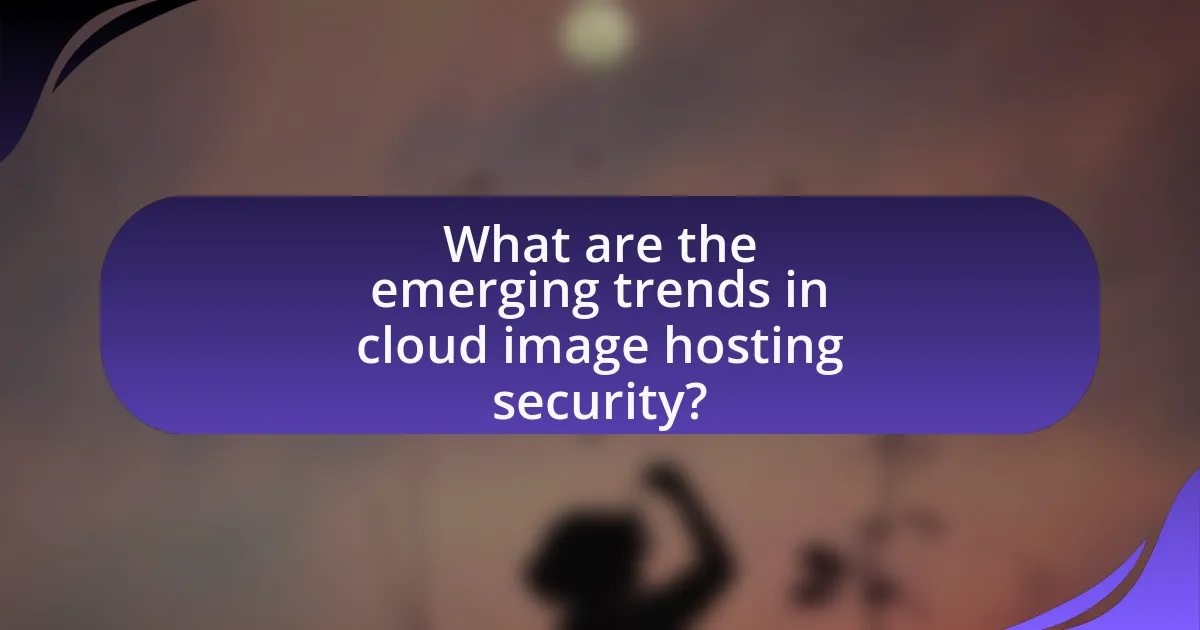
Emerging trends in cloud image hosting security include the adoption of zero-trust architecture, enhanced encryption methods, and the implementation of AI-driven security analytics. Zero-trust architecture minimizes trust assumptions by requiring continuous verification of user identities and device security, thereby reducing the risk of unauthorized access. Enhanced encryption methods, such as end-to-end encryption, ensure that images are protected both in transit and at rest, safeguarding sensitive data from breaches. AI-driven security analytics leverage machine learning to detect anomalies and potential threats in real-time, allowing for proactive responses to security incidents. These trends reflect a growing emphasis on robust security measures in response to increasing cyber threats in cloud environments.
How is artificial intelligence being used to enhance security?
Artificial intelligence is being used to enhance security by enabling advanced threat detection and response mechanisms. AI algorithms analyze vast amounts of data in real-time to identify unusual patterns and potential security breaches, significantly improving the speed and accuracy of threat identification. For instance, machine learning models can detect anomalies in user behavior, flagging potential insider threats or compromised accounts. Additionally, AI-driven systems can automate responses to security incidents, reducing the time it takes to mitigate threats. According to a report by McKinsey & Company, organizations that implement AI in their security protocols can reduce the average time to detect and respond to incidents by up to 90%.
What are the potential benefits of AI in threat detection?
AI enhances threat detection by improving accuracy, speed, and scalability in identifying potential security threats. By utilizing machine learning algorithms, AI can analyze vast amounts of data in real-time, detecting anomalies and patterns that may indicate a security breach. For instance, a study by IBM found that organizations using AI for threat detection can reduce the time to identify and contain a breach by up to 27%. Additionally, AI systems can continuously learn from new data, adapting to evolving threats more effectively than traditional methods. This capability not only increases the efficiency of threat detection but also minimizes the risk of false positives, allowing security teams to focus on genuine threats.
What limitations should organizations be aware of when using AI?
Organizations should be aware that AI systems can exhibit limitations such as bias, lack of transparency, and dependency on data quality. Bias in AI can lead to unfair outcomes, as algorithms may reflect the prejudices present in the training data, which has been documented in studies like “Algorithmic Bias Detectable in AI Systems” by Barocas and Selbst. Lack of transparency, often referred to as the “black box” problem, makes it difficult for organizations to understand how decisions are made, which can hinder accountability. Additionally, AI’s performance heavily relies on the quality and quantity of data; poor data can result in inaccurate predictions or decisions, as highlighted in the research “Data Quality and AI: A Critical Review” by Katal et al. These limitations necessitate careful consideration and management to ensure ethical and effective AI deployment.
What future technologies could impact cloud image hosting security?
Future technologies that could impact cloud image hosting security include quantum computing, advanced encryption methods, and artificial intelligence-driven security protocols. Quantum computing poses a risk to current encryption standards, as it has the potential to break traditional cryptographic algorithms, necessitating the development of quantum-resistant encryption techniques. Advanced encryption methods, such as homomorphic encryption, allow data to be processed in its encrypted form, enhancing security during data handling. Additionally, artificial intelligence can improve threat detection and response times by analyzing patterns and anomalies in real-time, thereby strengthening overall security measures. These technologies collectively represent significant shifts in how cloud image hosting security will be managed in the future.
How might blockchain technology improve security in cloud image hosting?
Blockchain technology can enhance security in cloud image hosting by providing decentralized data storage and immutable records. This decentralization reduces the risk of a single point of failure, making it more difficult for unauthorized users to access or manipulate stored images. Additionally, the immutable nature of blockchain ensures that once an image is uploaded, its integrity is preserved, as any changes would require consensus from the network, thus deterring tampering. Furthermore, blockchain can facilitate secure access controls through cryptographic keys, ensuring that only authorized users can view or modify images. These features collectively contribute to a more secure environment for cloud image hosting.
What role will quantum computing play in future security measures?
Quantum computing will significantly enhance future security measures by enabling the development of advanced cryptographic techniques that can withstand attacks from quantum algorithms. Traditional encryption methods, such as RSA and ECC, are vulnerable to quantum attacks, particularly Shor’s algorithm, which can factor large numbers efficiently. As a result, the transition to quantum-resistant algorithms, such as lattice-based cryptography, is essential for securing sensitive data in cloud image hosting and other applications. Research indicates that organizations must adopt these new cryptographic standards to protect against potential breaches as quantum computing technology matures.
What practical tips can organizations implement for secure cloud image hosting?
Organizations can implement several practical tips for secure cloud image hosting, including using encryption for data at rest and in transit, employing strong access controls, and regularly updating security protocols. Encryption protects images from unauthorized access, ensuring that even if data is intercepted, it remains unreadable. Strong access controls, such as multi-factor authentication and role-based access, limit who can view or modify images, reducing the risk of insider threats. Regularly updating security protocols, including software patches and vulnerability assessments, helps organizations stay ahead of potential security breaches. These practices collectively enhance the security posture of cloud image hosting environments.
How can organizations create a culture of security awareness among employees?
Organizations can create a culture of security awareness among employees by implementing comprehensive training programs that emphasize the importance of cybersecurity practices. Regular training sessions, workshops, and simulations can help employees understand potential threats and the necessary precautions to mitigate them. According to a study by the Ponemon Institute, organizations that conduct regular security awareness training reduce the likelihood of a security breach by 70%. Additionally, fostering open communication about security issues and encouraging employees to report suspicious activities can further enhance this culture.
What tools and resources are available for enhancing cloud image security?
To enhance cloud image security, tools and resources such as encryption software, access control mechanisms, and security monitoring services are essential. Encryption software, like AWS Key Management Service, protects images by converting them into unreadable formats, ensuring that only authorized users can access them. Access control mechanisms, such as role-based access control (RBAC) and identity and access management (IAM) solutions, restrict who can view or modify images, thereby minimizing unauthorized access. Security monitoring services, including intrusion detection systems (IDS) and cloud security posture management (CSPM) tools, continuously assess the security posture of cloud environments, alerting administrators to potential vulnerabilities or breaches. These tools collectively contribute to a robust security framework for cloud image hosting.
